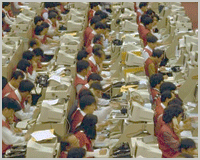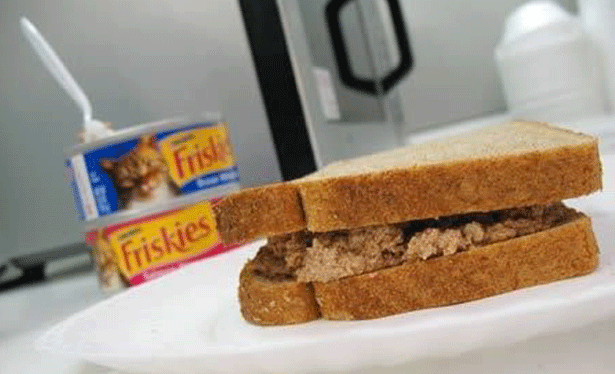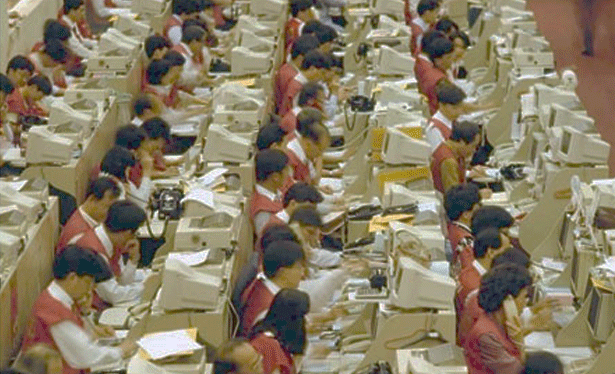Part-time jobs for creatives that help your business sense
 Let’s share a dirty little secret that really isn’t so secret: the economy is bad and it’s impossible to make money ends meet.
Whether you freelance or have a full-time position, chances are you are not earning enough to live a comfortable lifestyle. Sure, maybe you manage to pay all of your bills each month.
But maybe you live in fear that the roof will need fixing or you’re driving on bald tires or you have no health insurance—you are not alone.
We are all part of what is now being called the “99%.”
While at my last full-time job, most of us had a second job or paying hobby. It’s not that we weren’t well paid because we all made more than the average income for that city. Still, it just wasn’t enough when the kids needed braces on their teeth, summer camp, and those little things that come up in life when you least expect it…like eating.
Let’s share a dirty little secret that really isn’t so secret: the economy is bad and it’s impossible to make money ends meet.
Whether you freelance or have a full-time position, chances are you are not earning enough to live a comfortable lifestyle. Sure, maybe you manage to pay all of your bills each month.
But maybe you live in fear that the roof will need fixing or you’re driving on bald tires or you have no health insurance—you are not alone.
We are all part of what is now being called the “99%.”
While at my last full-time job, most of us had a second job or paying hobby. It’s not that we weren’t well paid because we all made more than the average income for that city. Still, it just wasn’t enough when the kids needed braces on their teeth, summer camp, and those little things that come up in life when you least expect it…like eating.
 Costs keep going up while fees and salaries are not. It’s a fact and if we can get past the egotistical part of human nature while some say they are “doing great,” we can explore second jobs that will actually help your business sense for freelancing and being better at that full-time position you have.
Costs keep going up while fees and salaries are not. It’s a fact and if we can get past the egotistical part of human nature while some say they are “doing great,” we can explore second jobs that will actually help your business sense for freelancing and being better at that full-time position you have.
Some of the limits you face
Time is precious. We have to shop for food, take care of our children, spend quality family time, and eventually sleep. That’s the human side. The business side can be tougher. If you work for a large company, chances are you signed a non-compete agreement. Basically, it means you can’t do freelance work along the lines of your titled position. If you are a designer, you can’t freelance creating design work. While at my last corporate gig, I was a graphic designer but designed web sites freelance. I had to apply for permission to do so from some corporate flunky hidden in the bowels of the main building in the “cult compound”—as we use to refer to the multi-building complex built from the long-lost blueprints for the Fourth Reich Berlin. Some fellow employees played in bands, or created fine art paintings and sculptures, sock monkeys and one-of-a-kind jewelry. We all knew who did what and there was no embarrassment as we were all in the same financial boat. When someone in the company decided my designing web sites was “too close” to our new web initiatives, I had to stop. A friend of mine made her extra money by catering weddings and events and asked if I would fill in for someone as a bartender. Playing with alcohol sounded like fun, so I agreed. When I showed up for the event, I saw that the wait staff and other bartender were all fellow designers from the company. It was pleasant, paid well and the tips weren’t bad…despite the nasty drunks who wanted to start fights with me—the male customers were much more civilized. This brings us to our first part-time job that will help your business, or at least bring in extra income without draining you of your creative juices.Food service
Everyone should work a food service position at one point in their lives to experience how stupid and thoughtless people are with waiters and waitresses. The public is insane, dirty, and thoughtless. Working in a service job has several great lessons that will help you in a freelance or office politics situation:- This is one of the best jobs to teach you how to handle different personalities and difficult situations.
- You learn humility and how to “take a bite of a poop sandwich” and say “yummy!”
- It teaches you the psychology of handling difficult personalities.
- You learn that sometimes you just have to smile and take it.
- You lean that the customer is not always right but you have to act as if they are.
- You learn to lead people into a decision. When they can’t order a simple hamburger from a numbered list with giant pictures, you learn the subtleties of leading a client into a firm decision for the best results.
Telemarketing
The better of the “hidden” second jobs: no one needs to know you are doing this if you want to keep your second job quiet. Telemarketing was one of the jobs I had while attending art school. Classes during the day and work at night, often getting out at 2:00 am. It’s not physically taxing but it’s selling and rejection can be frustrating. If you can hack it, this is a great position for helping you in business. Telemarketing firms use scripts you have to read. They also have sections with what is called “objection responses.” When the person you are speaking with says they don’t want to buy the new and improved whatever-it-is you are selling, you have a first objection response, a second, and a third all written out for you. By the way, the best way to get rid of a telemarketer is to tell them you already have the item or service and they will let you go right away. When I’m called about taking a subscription to the local newspaper, I ask if they have a Braille version because I’m blind. That gets rid of them really fast. When asked about taking a subscription to one of many magazines being offered, I ask if they carry some magazine with the most filthy, pornographic title I can think of. That also gets rid of them very quickly…unless they actually have one or more of those titles. I found, by using the simple lessons the telemarketing firm taught me for successful selling, I not only kept winning their sales prizes, which meant extra money on top of my salary and commission, but it also helped my freelance business once I left school. A job in telemarketing is good for:- Learning to take and shrug off rejection. It’s never personal so don’t take it that way.
- You can learn objection responses when dealing with a prospective client. It’s not tricking someone into using your services—it’s exhausting all possible negative responses to see if there is a reason for them to say “yes.”
- You learn proper telephone etiquette. Too many people just don’t know how important this is. As an art director, I grew very tired of rude morons who called me looking for work. I appreciated those who had good phone etiquette and would listen to what they had to say.
- It teaches you to talk to people. That’s a skill many freelancers, stuck behind a computer for many hours don’t have.
Office manager
 One of my first jobs out of art school was managing a small art studio. Although it was an art studio, my position was not a creative one. It didn’t pay much but it was great for my freelancing because I was being paid to learn about running a small business. If I made any mistakes, at least it wasn’t in my own business!
I don’t remember what I said to get hired but I had a sense of organization and a few of my art school jobs probably helped me get in the door. It gave me more than I thought it would.
I greeted clients, tracked and ordered supplies, kept financial books, organized the collection of art samples created by the artists the studio represented, answered the phone, did filing and wrote correspondence. If you are a freelancer, you need to learn all of these skills and, as I mentioned, better to learn at someone else’s expense, rather then your own. While I didn’t screw up at that job, I left with the ability to be more organized in my own studio and looked up the clients I befriended while working there. It doubled my clients immediately after leaving! The positive benefits of managing a small office is:
One of my first jobs out of art school was managing a small art studio. Although it was an art studio, my position was not a creative one. It didn’t pay much but it was great for my freelancing because I was being paid to learn about running a small business. If I made any mistakes, at least it wasn’t in my own business!
I don’t remember what I said to get hired but I had a sense of organization and a few of my art school jobs probably helped me get in the door. It gave me more than I thought it would.
I greeted clients, tracked and ordered supplies, kept financial books, organized the collection of art samples created by the artists the studio represented, answered the phone, did filing and wrote correspondence. If you are a freelancer, you need to learn all of these skills and, as I mentioned, better to learn at someone else’s expense, rather then your own. While I didn’t screw up at that job, I left with the ability to be more organized in my own studio and looked up the clients I befriended while working there. It doubled my clients immediately after leaving! The positive benefits of managing a small office is:
- Depending on the type of business, you’ll make contacts you can use for your own freelance business.
- You can learn bookkeeping and that’s HUGE in running your own business!
- In a small office, being a creative source that is on site, you might be able to do creative work for that business.
- You’ll learn day-to-day business management.
Delivery person
During a semester break in art school, a friend asked me if I could take over his job while he went away on vacation. The job consisted of making light deliveries and pick ups from businesses in my area. As I was paying for my own tuition and needed the money, I happily agreed. It was pretty boring and not very demanding. In the morning I got my delivery schedule, loaded the packages for the day and drove off for an eight-hour shift. I found it had other interesting benefits:- There’s no one looking over your shoulder all day. As long as deliveries are made on time, the boss doesn’t care.
- You meet people at different companies. Collect names, business cards, etc. and when the gig is done, approach them for design work. They won’t care that you delivered packages. If they think you are jovial and pleasant, they will be more than happy to listen to your proposal about designing for their business.
- While on the road, you can make calls or a stop here and there to take care of your own business as long as you make your deliveries. Another benefit to not having a boss looking over your shoulder!
- If you have eight hours to make deliveries but it only takes four hours, you have paid time to take a nap because, with two jobs, you’ll need a bit of rest.
Newspaper ad sales
We all really hate selling! Unfortunately, it’s part of our business. Selling ad space for a local newspaper will mean a lot of calls, visiting prospects, and keeping records of all your efforts to sell. As with other jobs mentioned here, the benefits are:- You’ll meet people! Maybe they WILL buy ad space. Maybe they need someone to DESIGN those ads. Maybe they will need a better logo or a web site. In a month of trying to sell ad space, you could meet 60 to 200 new small business owners.
- Maybe the newspaper needs some design work, too! Proximity can be the best reason for someone to give you design work.
- If you need to convince someone to advertise and they want someone to design their ad, perhaps the newspaper won’t mind you charging to design the ads? If the paper is generating ad revenue—hopefully more with you selling—why would they mind the methods you use to win over that business?
- They will have a prospect list with business names, contact information and type of business and they just HAND it to you! A copy of that might need to go home with you to “study it.” Good for their business, so if it gets left behind when you quit selling ad space, who will really care?
- Learning to sell something everyone needs but doesn’t want to pay for will sharpen your skills as a salesperson for your own business. After all, what client wants to pay for design, and we all know they need it!
- It’s a newspaper so the “insider information” is priceless. Get friendly with the copy desk editor or the editor of the business section!
Being a “fine artist”
Several of my coworkers did this for extra money. They were extremely talented painters. If you can make the time, maybe an hour a day, several days a week, you can create enough pieces for a gallery show over time. One friend created several dozen pieces every year for one gallery show where he would profit about $25,000 each show. He also used his “notoriety” to get grants around town for installations and special projects, adding what I suspect was another $25,000 at least. Another friend did it on a smaller scale. She created a set of skateboard decks with her art on them and had a small show at a friend’s restaurant. A nice little opening and she sold all the decks. A good payday that led to some professional work with her art on products. One small success leading to a bigger success. Eventually she left the company for which we both worked and found a much better job, due in part to her product work and of course, her talent. No list needed for this one. It’s a creative part-time job, so you can figure out the benefits and commitments for yourself.Zazzle or Café Press
As with being a fine artist, you can sell designs on products through Zazzle or Café Press. Yes, it’s another creative outlet but we are talking of economic gain and these sites can give you the extra money you need. Some call it “beach money” (you earn money while sitting on a beach) and once the designs are made, uploaded and placed on products, you can sit back and wait for the sales to be made while the sites produce, ship, and bill the consumer and you get a check for your cut. You will need to learn how to keep some records because, despite those producers handling everything, you need to know what you are selling, the taxes you have to pay on the income, and what, if any, deductions you can take on your taxes. Sound simple? Well, you will also need to market the designs through social media and possibly newspaper ads, which you might be selling if you follow the advice in a previous category listed above…or delivering those products if you follow yet another category listed in this article.Working for a former teacher
Yet another creative job…or not. When I left art school—mind you I didn’t graduate—I was offered some work by a couple of my teachers. One as a writer, coming up with sight gags for his comic feature in Playboy, for which I earned $10 per accepted gag, and another teacher who had me do odd jobs and writing for his studio. It eventually led to my being able to do work for a book with my name on it, so it was not high paying but a great benefit to a young creative just starting out. Chances are you’ll be cleaning up, making copies, and shining shoes. It’s okay because you are also being mentored.Teaching
From time to time, I teach a course on design or art for kids on Saturdays. I enjoy the kids with their unspoiled view of art and their fresh creativity inspires me in my daily work. The pay isn't great but this is one of those jobs you don't do for the money.Writing or blogging
This is my personal favorite, for obvious reasons. There are sites that pay for content. If you can string a couple of sentences together with some kind of point to ranting and babbling, chances are someone will buy your articles. Maybe a local paper wants someone to write reviews of art shows or a museum? Maybe you’re an avid foodie and can write eatery reviews. Maybe you have a book within you but don’t want to go through the 29 rejections JK Rowling went through before someone thought Harry Potter might have some merit. Amazon now has an ebook publishing program where you get up to 70% of all sales. Spend your lunch hour typing up a chapter and before you know it, you’ll have your book…although, don’t do it on your work computer if you’re writing about blowing the top off the industry in which you work. Can you create a site that can be monetized (ads with click-thrust, associate sales programs)? You will have to keep the content fresh and advertise it to bring in hits. It’s not an easy job and it’s a daily commitment. It also doesn’t have an instant return. With a part-time job, you have a check at the end of the week. With self-initiated second incomes, you invest time and effort and hopefully can start seeing a return within six months to a year.Look around for interesting part-time jobs
 The beauty of a creative outlet is you feel proud of your efforts but they are a commitment and are an investment in your future. A non-creative job can be left behind if you receive a raise at your staff job or if you garner more freelance clients. There is no emotional bond. Look at the want ads of job sites and try to imagine what you can learn from the jobs listed. Every job has possibilities and lessons. Be creative when considering what YOU will get out of a job, aside from extra income. Certainly paying for something like health insurance or taking your family on a fabulous vacation is a reward that is tangible. I wish I could say the economic bad times will be over soon. I wish we all could be paid what we are worth but when was creativity ever really paid what it was worth?
Do you work a "second job?" Tell us what you do and how it helps your career. If you had to work to make another income, what would you prefer to do?
The beauty of a creative outlet is you feel proud of your efforts but they are a commitment and are an investment in your future. A non-creative job can be left behind if you receive a raise at your staff job or if you garner more freelance clients. There is no emotional bond. Look at the want ads of job sites and try to imagine what you can learn from the jobs listed. Every job has possibilities and lessons. Be creative when considering what YOU will get out of a job, aside from extra income. Certainly paying for something like health insurance or taking your family on a fabulous vacation is a reward that is tangible. I wish I could say the economic bad times will be over soon. I wish we all could be paid what we are worth but when was creativity ever really paid what it was worth?
Do you work a "second job?" Tell us what you do and how it helps your career. If you had to work to make another income, what would you prefer to do?
Speider Schneider
Speider Schneider is a former member of The Usual Gang of Idiots at MAD Magazine and has designed products for Disney/Pixar, Warner Bros., Harley-Davidson, ESPN, Mattel, DC and Marvel Comics, Cartoon Network and Nickelodeon among other notable companies. Speider is a former member of the board for the Graphic Artists Guild, co-chair of the GAG Professional Practices Committee and a former board member of the Society of Illustrators. Follow him on Twitter @speider or add him on Google+
Read Next
15 Best New Fonts, July 2024
Welcome to our monthly roundup of the best fonts we’ve found online in the last four weeks. This month, there are fewer…
By Ben Moss
20 Best New Websites, July 2024
Welcome to July’s round up of websites to inspire you. This month’s collection ranges from the most stripped-back…
Top 7 WordPress Plugins for 2024: Enhance Your Site's Performance
WordPress is a hands-down favorite of website designers and developers. Renowned for its flexibility and ease of use,…
By WDD Staff
Exciting New Tools for Designers, July 2024
Welcome to this July’s collection of tools, gathered from around the web over the past month. We hope you’ll find…
3 Essential Design Trends, July 2024
Add some summer sizzle to your design projects with trendy website elements. Learn what's trending and how to use these…
15 Best New Fonts, June 2024
Welcome to our roundup of the best new fonts we’ve found online in the last month. This month, there are notably fewer…
By Ben Moss
20 Best New Websites, June 2024
Arranging content in an easily accessible way is the backbone of any user-friendly website. A good website will present…
Exciting New Tools for Designers, June 2024
In this month’s roundup of the best tools for web designers and developers, we’ll explore a range of new and noteworthy…
3 Essential Design Trends, June 2024
Summer is off to a fun start with some highly dramatic website design trends showing up in projects. Let's dive in!
15 Best New Fonts, May 2024
In this month’s edition, there are lots of historically-inspired typefaces, more of the growing trend for French…
By Ben Moss
How to Reduce The Carbon Footprint of Your Website
On average, a web page produces 4.61 grams of CO2 for every page view; for whole sites, that amounts to hundreds of KG…
By Simon Sterne
20 Best New Websites, May 2024
Welcome to May’s compilation of the best sites on the web. This month we’re focused on color for younger humans,…














